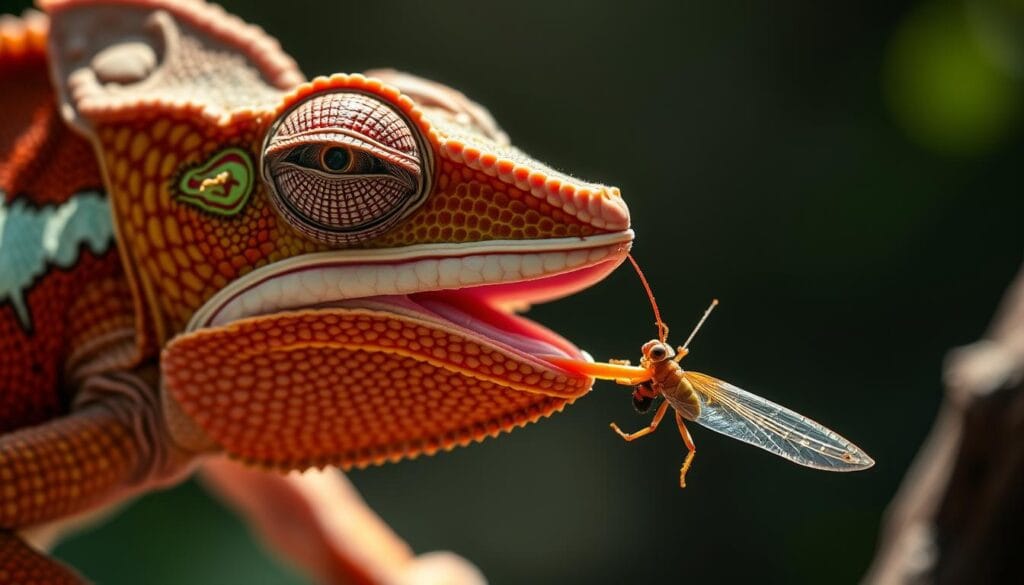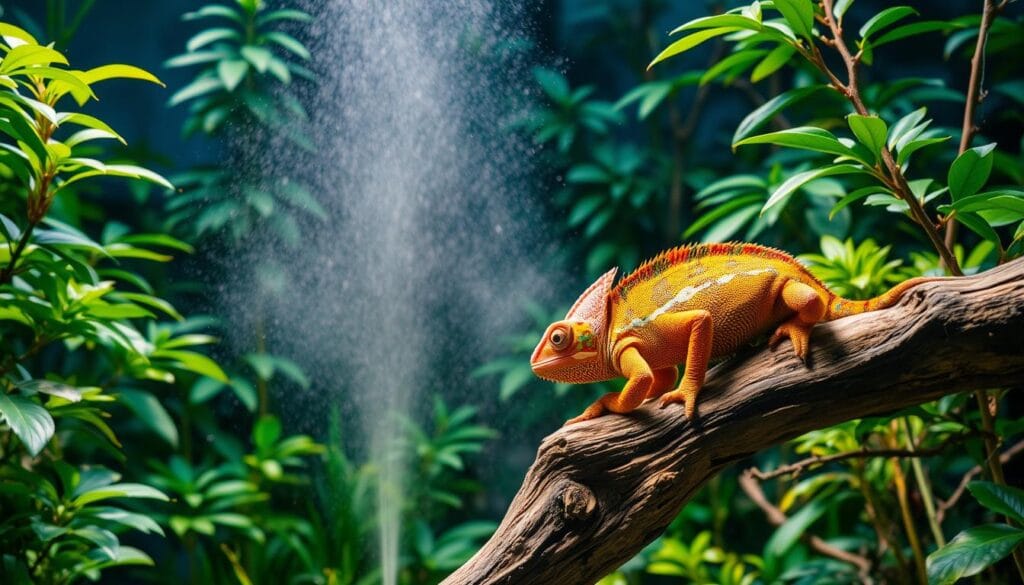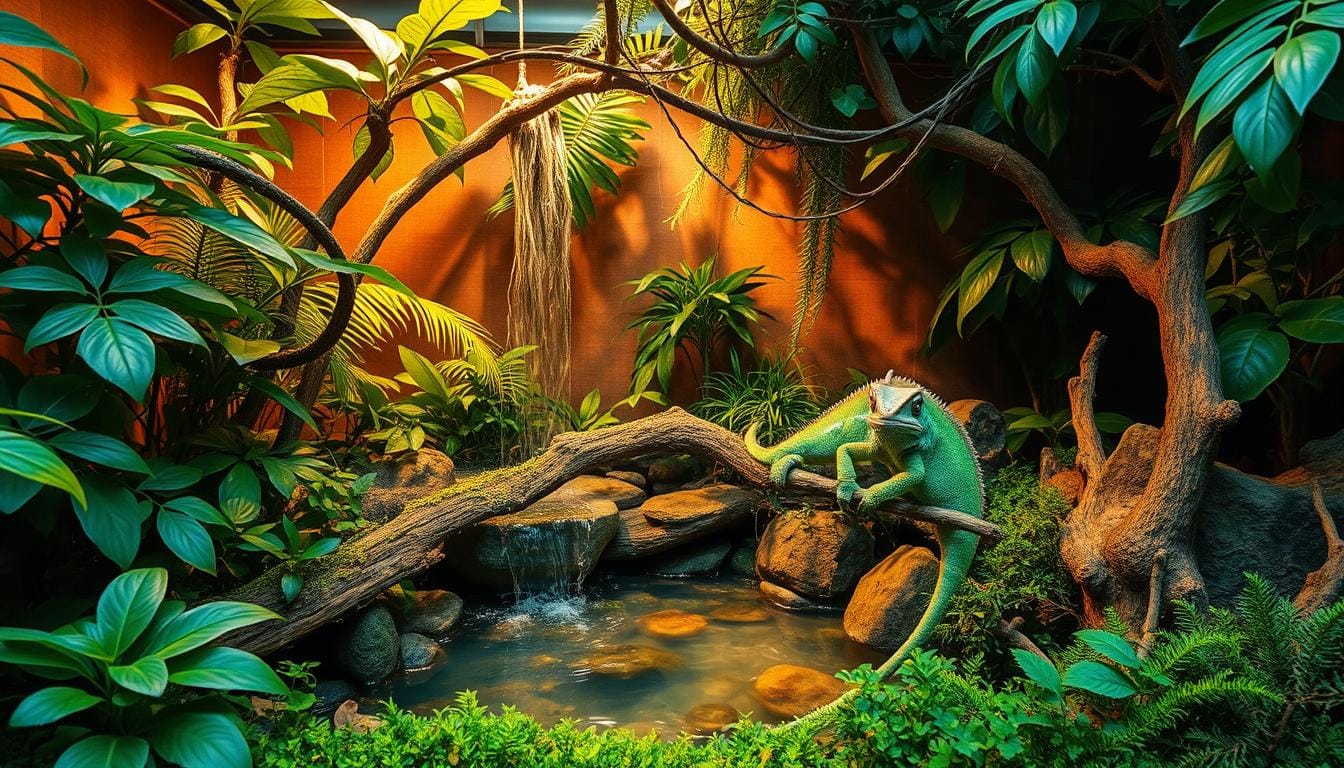My first time seeing a chameleon was unforgettable. It was a vibrant veiled chameleon at a local pet store. Its colors changed like a living painting. Setting up a chameleon terrarium is more than just building an enclosure. It’s about creating a mini world that matches their natural habitat.
Chameleons are not like other pets. They need careful attention when setting up their habitat. You must understand their special needs and create a space that supports their lifestyle.
A good chameleon enclosure is more than just a place to live. It’s a detailed environment that keeps them physically and mentally healthy. Every aspect, from vertical space to temperature, is important for their well-being.
Table of Contents
Understanding Chameleons and Their Needs
Chameleons are fascinating reptiles that need special care. When setting up a chameleon cage, knowing their unique needs is key. These animals are more than just color-changing lizards. They are complex creatures with specific needs that require careful thought.
There are many chameleon species, each with its own traits. These traits affect their tank needs. Let’s look at some popular pet chameleon types:
- Veiled Chameleons: Native to Yemen, known for distinctive casques
- Panther Chameleons: Colorful species from Madagascar
- Jackson’s Chameleons: Smaller species with unique three-horned appearance
Natural Habitat Characteristics
Knowing a chameleon’s natural habitat is key to creating a great home. Most chameleons come from tropical and subtropical areas. They live in places with:
- Dense vegetation
- High humidity levels
- Moderate to warm temperatures
- Plenty of vertical climbing spaces
“Replicating a chameleon’s natural habitat is the key to their health and happiness in captivity.”
Behavioral Insights
Chameleons are solitary animals with unique behaviors. These behaviors affect their care. They like:
- Multiple hiding spots
- Vertical climbing structures
- Low-stress environments
- Privacy and minimal direct interaction
Understanding these traits helps you create a great habitat. It meets your chameleon’s physical and mental needs.
Choosing the Right Enclosure for Your Chameleon
Creating the perfect chameleon vivarium is key for your pet’s health and happiness. The right enclosure can greatly improve your reptile’s life. It should be comfortable and stimulating, like their natural habitat.
Size is important when picking an enclosure. Experts say a minimum of 2′ x 2′ x 4′ is best for most chameleons. Wider cages are better than taller ones because chameleons move more side to side.
Enclosure Types: Pros and Cons
There are three main types of chameleon enclosures:
- Screen Cages:
- Great ventilation
- Fast temperature and humidity changes
- Perfect for seasonal needs
- Hybrid Cages:
- PVC sides for better humidity
- Stable environment
- Glass Terrariums:
- Keeps heat and humidity well
- Needs careful humidity control
- Risk of respiratory infections
Ventilation and Accessibility Considerations
Your chameleon’s vivarium should focus on good ventilation and easy upkeep. The ZooMed Reptibreeze XL is a good starting point. Look for cages with:
- Many ventilation points
- Removable trays for drainage
- Easy-to-clean entry points
- Options for lighting and misting
The aim is to make a space where your chameleon can flourish. It should be like their natural tree canopy but also easy for you to maintain.
Essential Equipment for Your Habitat
Setting up a great home for your chameleon needs the right gear. You’ll need special lighting, heating, and ways to keep your pet hydrated. These things help make a space that feels like their natural home.
Lighting: UVB and Heat Sources
UVB lighting is key for your chameleon’s health. It helps with calcium and vitamin, which stops bone disease. Choose top-notch UVB bulbs for:
- 10-12 hours of light each day
- Changing bulbs every six months
- Lighting that offers both direct and indirect rays
Heating Elements: Maintaining Optimal Temperatures
Your chameleon’s home needs the right temperature zones. Use ceramic heat bulbs and basking lights to create the perfect temperature spots.
| Temperature Zone | Recommended Range |
|---|---|
| Daytime Ambient | 72-80°F |
| Basking Spot | 85-95°F |
| Nighttime | 65-70°F |
Watering Systems: Hydration Strategies
Chameleons don’t drink from water bowls. They need special ways to stay hydrated:
- Misting Systems: Use twice a day
- Drip Systems: Keep water moving
- Keep humidity at 50-80%
“The right equipment turns a simple space into a thriving chameleon home.” – Exotic Pet Experts
Substrate and Decor for Your Chameleon’s Home
Creating the perfect chameleon terrarium is more than picking an enclosure. You want to make a habitat that feels like home for your chameleon. This means choosing the right substrate, plants, and climbing spots.
Selecting the Best Substrate Materials
When picking substrate, look for materials that keep things clean and moist. Flat newspaper is a top choice because it’s:
- Easy to throw away
- Good for the planet
- Simple to clean
- Keeps bacteria away
Stay away from small stuff like sand or gravel. They can hold too much water and hurt your pet. A clean terrarium base is key for your chameleon’s health.
Adding Plants and Climbing Structures
Put in plants that like humid air and offer places to hide. Good plants include:
- Snake plants
- Pothos
- Ferns
These plants make your terrarium look great and keep it humid. Add branches of different sizes to help your chameleon climb.
Creating Hiding Spots and Perches
Chameleons need lots of places to perch and hide. Your enclosure should have:
- Vertical climbing space
- Multiple branch levels
- Dense foliage for hiding
- Temperature zones
Your terrarium should be 24-48 inches tall. This gives your chameleon enough room to move and play.
Maintaining Ideal Temperature and Humidity Levels
Creating the perfect environment is key for your chameleon’s health. A well-designed enclosure needs careful attention to temperature and humidity. This helps mimic their natural habitat.
Chameleons are sensitive and need specific conditions to thrive. Your cage setup must offer precise temperature and humidity levels. This keeps your pet healthy and comfortable.
Temperature Zones: Creating the Perfect Climate
Successful chameleon care means setting up different temperature zones in the enclosure:
- Basking area: 85-95°F (29-35°C)
- Ambient temperature: 72-80°F (22-27°C)
- Nighttime temperature: 65-70°F (18-21°C)
Measuring Humidity: Essential Tools
Monitoring humidity is vital for your chameleon’s health. Use these key tools:
- Digital hygrometer for accurate readings
- Misting systems to keep 50-70% daytime humidity
- Nighttime humidity levels between 70-100%
Seasonal Adjustments for Indoor Habitats
Indoor environments need careful management for seasonal changes. Consider these strategies:
- Use adjustable heating elements
- Implement seasonal lighting cycles
- Regularly check temperature and humidity levels
Pro Tip: A basking branch should feel warm to the touch but not hot when you place your hand near it.
By managing your chameleon’s environment, you’ll create a healthy, comfortable habitat. This supports their unique needs and promotes long-term well-being.
Feeding Your Chameleon: Diet and Nutrition

It’s key to feed your chameleon right to keep them healthy and long-lived. Knowing what they need helps you set up the best home for them. This supports their special diet needs.
Live Insect Food Options
Chameleons love to eat insects. They need live bugs for good health.
- Crickets: High-protein staple food
- Dubia Roaches: Easily digestible with soft exoskeleton
- Silkworms: Rich in protein and amino acids
- Hornworms: Excellent for hydration
- Butterworms: High calcium content
Vitamin and Mineral Supplementation
Adding vitamins is part of keeping your chameleon healthy. It stops them from getting too little of what they need.
| Supplement Type | Frequency | Purpose |
|---|---|---|
| Calcium Powder | Every feeding | Bone health, growth support |
| Multivitamin | Weekly | Overall nutritional balance |
| Vitamin A | As recommended | Immune system support |
Hydration and Drinking Habits
Chameleons drink water in special ways. They like to get water from leaves, not from standing water.
- Mist enclosure 1-2 times daily
- Use drip systems for consistent water access
- Maintain humidity between 50-75%
Pro tip: Mix up the insects to keep meals interesting for your chameleon.
Monitoring Health and Behavior
Keeping your chameleon healthy means watching them closely and taking action early. Knowing about health problems and spotting signs early can stop big issues. This is key for your chameleon’s well-being.
Common Health Issues and Symptoms
Chameleons face many health issues that need quick action. Look out for these signs:
- Unusual color changes or dull skin
- Lethargy or reduced movement
- Abnormal eating habits
- Respiratory difficulties
- Swollen joints or limbs
Regular Check-ups and Vet Visits
Seeing a vet is vital for your chameleon’s health. Here’s what to do:
- Schedule annual reptile veterinarian check-ups
- Perform monthly health assessments
- Monitor weight and physical condition
Stress Factors in Chameleons
Stress can harm your chameleon’s health. Here are things that might stress them out:
| Stress Factor | Potential Impact |
|---|---|
| Improper temperature | Weakened immune system |
| Inadequate humidity | Skin and respiratory issues |
| Excessive handling | Behavioral changes |
| Inappropriate vivarium setup | Chronic stress |
By being alert and creating a good home for your chameleon, you can keep them healthy and happy for a long time.
Cleaning and Maintaining the Habitat

Keeping a chameleon’s habitat clean is key to their health. A clean, well-kept environment is vital. It must mimic their natural home. Setting up a chameleon habitat is just the start. Ongoing care is needed to keep your pet happy and healthy.
Routine Cleaning Schedule
Having a cleaning schedule is essential for your chameleon’s health. Here’s a detailed plan:
- Daily tasks:
- Remove uneaten food
- Spot clean waste
- Check water droplets and misting system
- Weekly responsibilities:
- Replace substrate
- Clean and disinfect feeding areas
- Trim live plants
- Monthly deep cleaning:
- Thoroughly sanitize entire enclosure
- Inspect and clean climbing branches
- Check lighting and heating elements
Products to Use and Avoid
When cleaning your chameleon’s home, pick your products wisely:
- Safe options:
- Reptile-specific disinfectants
- Diluted vinegar solution
- Mild, unscented soap
- Products to avoid:
- Harsh chemical cleaners
- Bleach-based solutions
- Fragranced cleaning agents
Preventing Pests and Contaminants
Keep your chameleon safe from pests and contaminants with these tips:
- Quarantine new plants before introducing them
- Regularly inspect substrate for mold or fungus
- Maintain proper humidity levels (40-70%)
- Use bioactive setups to naturally control microorganisms
“A clean habitat is a healthy habitat” – Reptile Care Experts
Tips for Long-Term Chameleon Care
Caring for a chameleon is a rewarding journey. It requires dedication and understanding of their unique needs. Most chameleon species live between 3 to 8 years in captivity. Proper care is key to their longevity.
When setting up your chameleon terrarium, consider your pet’s specific needs. This ensures their health and comfort. As your chameleon ages, its habitat needs will change.
Your chameleon enclosure should grow with your pet. Veiled chameleons, for example, can grow up to 24 inches long. They need larger spaces to prevent stress and ensure movement.
Interaction with your chameleon should be gentle. These solitary creatures prefer minimal handling. Limit contact to 10-15 minute sessions 2-3 times weekly.
Watch for signs of stress, such as color changes or body language. This indicates when your pet needs space. Regular veterinary check-ups and careful observation of diet, temperature, and humidity are essential. They help maintain your chameleon’s health throughout its lifetime.
By understanding your chameleon’s unique needs and providing a well-maintained environment, you’ll create a supportive home. Remember, each chameleon has its own personality. Patience is key to building a lasting bond with these fascinating creatures.


Youre so cool! I dont suppose Ive learn anything like this before. So good to find anyone with some original thoughts on this subject. realy thanks for starting this up. this web site is something that’s wanted on the web, somebody with somewhat originality. useful job for bringing something new to the web!